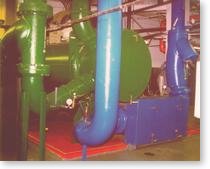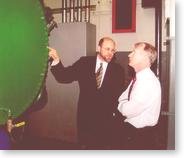Trane New York / New Jersey
Sheraton Hotel New York
New York, NY, Jun 3, 1997
New York Sheraton Chiller Replacement Planned to be "Invisible" to Guests
The Sheraton New York Hotel and Towers is located in Manhattan on Seventh Avenue between 52nd and 53rd Streets. The 50-story hotel is ideally situated for both business and leisure travelers in the busy heart of the city, near Rockefeller Center and the Theater District. Adjoining retail and business centers, this 1.2 million square-foot facility encompasses 1,750 guestrooms and a wide variety of dining, entertainment and business meeting options. Hotel guests seldom think about the climate control system that serves the hotel; but, for the hotel's engineering staff, comfort systems are a constant concern.
Evaluation was the First Step
 According to the hotel's property operations manager, Ian Murray, the hotel recently re-evaluated its air conditioning chilled water plant, with an eye to assuring continued system reliability and operating economy. The hotel was built in 1962 and was operating on its original chiller plant. That plant had included two 1,100-ton steam turbine-driven centrifugal chillers, and one 400-ton electric centrifugal machine. Steam for the two large machines was supplied by New York's district steam system.
According to the hotel's property operations manager, Ian Murray, the hotel recently re-evaluated its air conditioning chilled water plant, with an eye to assuring continued system reliability and operating economy. The hotel was built in 1962 and was operating on its original chiller plant. That plant had included two 1,100-ton steam turbine-driven centrifugal chillers, and one 400-ton electric centrifugal machine. Steam for the two large machines was supplied by New York's district steam system.
 "The steam machines were great in their time," says Murray, "but we suspected they were near the end of their useful lives and wanted to look at all the options." The hotel retained the consulting firm of Jaros, Baum and Bolles (JBB) to evaluate the present system and suggest chiller replacement options. The consultant looked not only at replacement chiller choices, but also at the physical planning requirements of a plant upgrade.
"The steam machines were great in their time," says Murray, "but we suspected they were near the end of their useful lives and wanted to look at all the options." The hotel retained the consulting firm of Jaros, Baum and Bolles (JBB) to evaluate the present system and suggest chiller replacement options. The consultant looked not only at replacement chiller choices, but also at the physical planning requirements of a plant upgrade.
The hotel's mechanical room is located in a deep sub-basement. Although the mechanical room is quite roomy, access to it with large equipment is very challenging. Any equipment moved in or out requires extensive planning. The ultimate recommendation of the engineer, and the choice of the owner, was to replace the steam turbine machines with new high-efficiency centrifugal chillers.
The economic analysis revealed that the steam turbine option was not as attractive as it had been when the hotel was built. Up until 1995, Consolidated Edison had offered rebates as high as $500 per ton for new steam refrigeration installations. In 1995, possibly influenced by electric deregulation on the horizon, the practice of offering these rebates for steam installations halted. For the first time in nearly ten years, the economic choice between electric and steam based refrigeration equipment had to stand on its own.
Surprising Payback Time
 The analysis by JBB revealed that electric centrifugal machines could save significantly in building operating costs for this 24 hour per day operation. During off-peak (evening and weekend) hours the hotel is able to take advantage of low rates to operate at a cost of less than three cents per ton-hour, versus nearly ten cents for steam. The Sheraton accepted bids for high efficiency chiller alternatives in addition to the .62 kW/ton base bid. Alternatives for machines with .565 and .528 kW/ton were analyzed against the additional first cost of these higher efficiency machines. In the end, the .528 kW/ton bid was accepted. This alternative promised a payback of less than 3.5 years. This longer term outlook was selected by The Sheraton against the .565 kW/ton option, which would have had a payback of less than 3 years.
The analysis by JBB revealed that electric centrifugal machines could save significantly in building operating costs for this 24 hour per day operation. During off-peak (evening and weekend) hours the hotel is able to take advantage of low rates to operate at a cost of less than three cents per ton-hour, versus nearly ten cents for steam. The Sheraton accepted bids for high efficiency chiller alternatives in addition to the .62 kW/ton base bid. Alternatives for machines with .565 and .528 kW/ton were analyzed against the additional first cost of these higher efficiency machines. In the end, the .528 kW/ton bid was accepted. This alternative promised a payback of less than 3.5 years. This longer term outlook was selected by The Sheraton against the .565 kW/ton option, which would have had a payback of less than 3 years.
The New Package
The equipment chosen to replace the two large steam units was a pair of 1,100-ton Trane CenTraVac® two-stage chillers. According to Murray, the hotel made the decision to order the high-efficiency centrifugal chillers on the basis of long-term operating savings. Murray notes, "These are major pieces of equipment you're going to have for a long time. You have to look at efficiency."
Other Special Concerns
Murray points out another important requirement. "We absolutely insisted that we had to have a continuous stream of chilled water. We don't have the luxury of shutting down the plant. In the hotel business, guest comfort is paramount." For that reason, the job had to be designed for a time of year other than the peak cooling months. And the first of the new chillers had to be on line before the last old unit was taken off line." In the end, the work was completed between November 18, 1996 and June 3, 1997.
| The analysis by JBB revealed that electric centrifugal machines could save significantly in building operating costs for this 24 hour per day operation. |
 Another Success Story
Another Success Story
The result of the Sheraton chiller project is a new, highly efficient chiller plant installed with virtually no impact on the convenience, comfort or occupancy levels of the hotel. And as far as the hotel guests were concerned, it never happened.
[Read More]


